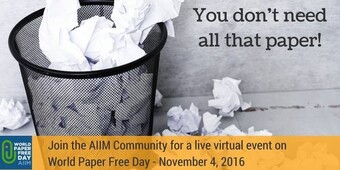You can celebrate the „World Paper Free Day” every day
2016-11-03
Let's make the World Paper Free Day more often
 Do you know how old is the vision of the paperless office? Probably no one knows exactly when it all began. However, given the fact that the magazine BusinessWeek published an article about the paperless office already in 1975, we can say with certainty that this idea is at least 40 years old.
Do you know how old is the vision of the paperless office? Probably no one knows exactly when it all began. However, given the fact that the magazine BusinessWeek published an article about the paperless office already in 1975, we can say with certainty that this idea is at least 40 years old.
For decades we have been listening to visionaries’ forecasts of the world in which paper will have no place. For example, Paul Saffo- the American Institute of Future director- claimed in early 90s that paper is on track to pass the baton to another medium. In his view, by the end of the last millennium, digital paper and so-called scrollable computer should have become a commonplace reality.
Counterfactual scenario
 But the reality is different. Not only did the traditional paper not disappear from our lives, but we use it more and more. Global consumption has grown by about half in the last three decades, and today it exceeds 400 million tons per year. Estimates suggest that by 2025 it should be up to 500 million tons.
But the reality is different. Not only did the traditional paper not disappear from our lives, but we use it more and more. Global consumption has grown by about half in the last three decades, and today it exceeds 400 million tons per year. Estimates suggest that by 2025 it should be up to 500 million tons.
Not only emerging economies are responsible for the long-term growth, but paradoxically also technologies. For example, Internet and emails have actually increased paper consumption. Nowadays, an average person uses at work in the office unbelievable 10,000 sheets of paper per year, says the Paperless Project, whereby -at the end of the day- almost half of them ends up in the garbage.
The main reason of enormously high consumption lies in the fact that people simply like paper. It is lightweight, flexible and pleasant to the touch. It is easy to grab, move and fold. And despite all the technological advances, most people still prefer making notes with a pen on paper to making them digitally in a tablet or smartphone.
Why to become more modest
 At the beginning of November there is the World Paper Free Day, an initiative that encourages people and businesses to –for at least one day- reduce the consumption of popular paper to a minimum. However; we should consider the necessity and effectiveness to print and use the documents more often than once a year.
At the beginning of November there is the World Paper Free Day, an initiative that encourages people and businesses to –for at least one day- reduce the consumption of popular paper to a minimum. However; we should consider the necessity and effectiveness to print and use the documents more often than once a year.
One reason is environmental. The paper consumption is extremely environmentally unfriendly. For illustration, an average Belgian "liquidates" nearly nine 12-meters-high trees per year by using the paper; an Austrian less than seven, a Japanese six, a Dutchman more than five and a Chinese less than two trees. Throughout its life a common tree can absorb almost ton of carbon dioxide and produce about 118 kg of oxygen per year.
Not only absorbs the production of paper almost half (42%) of the world's timber, but the pulp and paper industry spends more water than any other industry during the production. If the paper is not recycled, it ends up in landfills, and it forms one fifth to one-third share in the total volume of garbage.
No more excuses
If you are no altruist or you do not consider the risks for the future of our planet well-founded, you may be more interested in economic efficiency and effectiveness of paperless processes. In this case you might come across sceptical voices that highlight the disadvantages or even the futility of efforts to eliminate paper. Here are some of them.
- We won´t get rid of paper anyway because certain documents must be signed in manuscript. It is not true. Nowadays, even small businesses can have their contracts, acceptance reports, bills of delivery or certificates of revisions or service interventions signed by customers digitally. Certain models of tablets can record a signature, including biometrics, by a stylus on the screen, and then the software allows to connect it with any document and save it into a tablet, and also synchronize them with a remote server. If documents are signed for example with a digital handwritten signature, which is in line with the legislation on electronic signatures, it means they are just as valid as if in writing.
- We work in a specific field where solutions for the documents and process digitization are not available.The digitization is one of the most visible trends of recent years. The solutions are being generated also in the areas where perhaps you would not expect it. An example could be the software for management companies that helps maintain the overview of managed assets and building management, record the payment discipline, process the annual accounts, or for example, read the meters using the Android mobile applications. Of course, everything in it can be archived electronically, and also apartment owners have access to selected documents, such as billings, payment prescriptions and minutes of meetings, through the web. Similar examples of digitization exist also in production and logistics.
- What if the system fails and digital documents are not available, or we become the target of a cyber attack? The sceptics of digitization often worry that in case of technology failure a worker or the entire company remain paralyzed. Or that the data will leak, whereas today the online world is extremely risky. However, when backing up and applying the security measures properly, digital documents are safer than paper. In the case of catastrophic loss of paper records- for example in case of fire or flooding- most companies (70%) would close in three weeks.
Without exaggerated expectations
If you succeed to eliminate paper in the office at least partially, your business will probably need less space because smaller offices and archival spaces will suffice. Your people will gain access to documents from anywhere, and they will find it easier to get oriented in them. And as paperless processes tend to be more efficient, you will create prerequisites to provide better customer service.
Despite all advantages, there is no sense to stubbornly insist on going completely "paperless". The world is not black and white, and the way to cleaner and more efficient companies does not have to be radical. But thinking about where it is possible to dispense with paper, and in which cases it would be more efficient to digitize processes mean helping the surrounding environment and also your business.
You might be inspired by:
Actual paperless production becomes reality - EMANS
eIDAS, new European regulation simplifies signature-based electronic transactions







